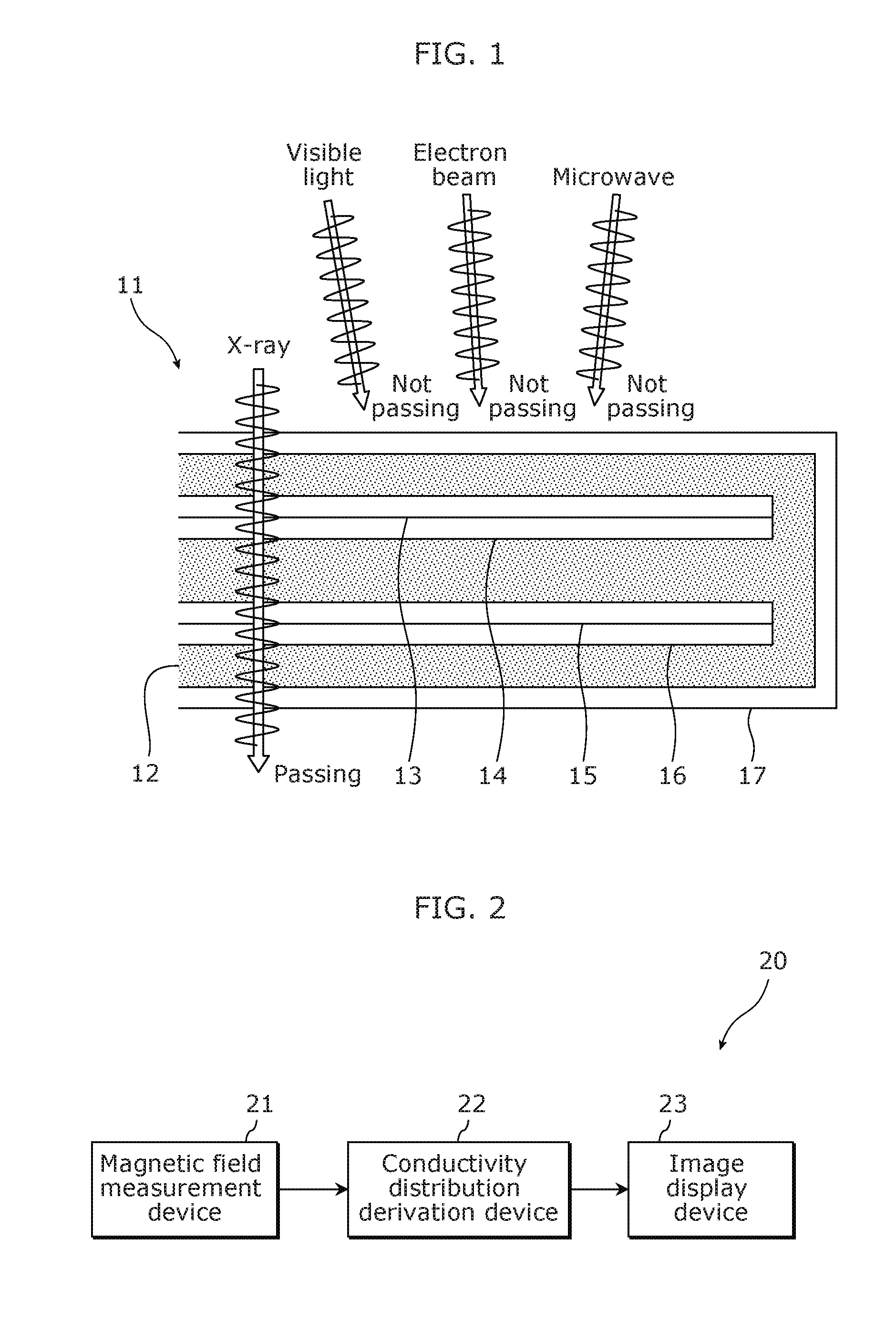Conductivity distribution derivation method and conductivity distribution derivation device
- Summary
- Abstract
- Description
- Claims
- Application Information
AI Technical Summary
Benefits of technology
Problems solved by technology
Method used
Image
Examples
embodiment
[0038]FIG. 1 illustrates a reference example of a battery inspection method. A battery 11 illustrated in FIG. 1 includes an electrolyte 12, an electric current collector 13, a positive electrode active material 14, a negative electrode active material 15, an electric current collector 16, and a metal package 17. The electrolyte 12, the electric current collector 13, the positive electrode active material 14, the negative electrode active material 15, and the electric current collector 16 are covered with the metal package 17.
[0039]Examples of a technical element used in non-destructive inspection include X-ray, visible light, electron beams, microwaves, and ultrasound waves. Among them, visible light, electron beams, and microwaves are not expected to be used for inspecting the battery 11 in a non-destructive manner because the transmittance of visible light, electron beams, and microwaves through the battery 11 is zero. High brightness X-ray can be used for inspecting the battery 1...
example 1
Extended Example 1
[0099]First, Extended example 1 is described. In Extended example 1, the derivation unit 32 of the conductivity distribution derivation device 22 determines a model for the conductivity distribution σ and a model for the electric potential distribution [Math. 36], and derives the x component Hx of the magnetic field vector and the y component Hy of the magnetic field vector on the basis of the model for the conductivity distribution σ and the model for the electric potential distribution [Math. 37].
φ [Math. 36]
φ [Math. 37]
The mode is also referred to as a candidate. When the derived x component Hx and y component Hy fit the magnetic field information obtained through the magnetic field measurement device 21 or the like, the derivation unit 32 determines a model for the conductivity distribution σ and a model for the electric potential distribution [Math. 38] as the conductivity distribution σ and the electric potential distribution [Math. 39].
φ [Math. 38]
φ [Mat...
example 2
Extended Example 2
[0111]Next, Extended example 2 is described. In Extended example 2, the derivation unit 32 of the conductivity distribution derivation device 22 derives the conductivity distribution σ according to a relational expression that allows the conductivity distribution σ to be derived directly from the magnetic field information. The relational expression that allows the conductivity distribution σ to be derived directly from the magnetic field information is derived from Expression 11. The following describes in detail the relational expression that is derived from Expression 11.
[0112]First, Expression 12 is derived by substituting [Math. 51] of the third equation in Expression 11 into the first terms on the right side of the first equation and the second equation in Expression 11.
[Math. 51]
σ(x,y)φ(x,y)
[Math. 52]
ΔHx=h2σ0∂y{∂x2φ+∂y2φ}δ(z−z0)−σ0h{∂yφ(x,y)}δ′(z−z0)
ΔHy=h2σ0∂x{∂x2φ+∂y2φ}δ(z−z0)−σ0h{∂xφ(x,y)}δ′(z−z0) Expression 12
[0113]Next, Expression 14 is derived by the ...
PUM
 Login to View More
Login to View More Abstract
Description
Claims
Application Information
 Login to View More
Login to View More - R&D
- Intellectual Property
- Life Sciences
- Materials
- Tech Scout
- Unparalleled Data Quality
- Higher Quality Content
- 60% Fewer Hallucinations
Browse by: Latest US Patents, China's latest patents, Technical Efficacy Thesaurus, Application Domain, Technology Topic, Popular Technical Reports.
© 2025 PatSnap. All rights reserved.Legal|Privacy policy|Modern Slavery Act Transparency Statement|Sitemap|About US| Contact US: help@patsnap.com



